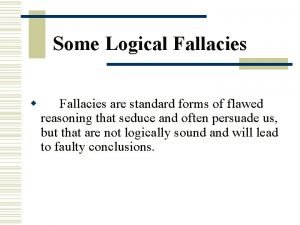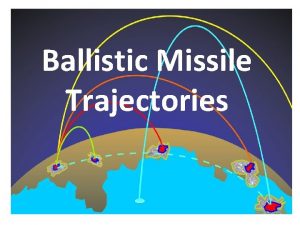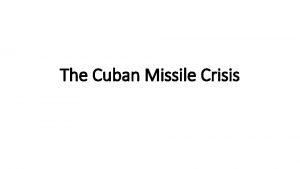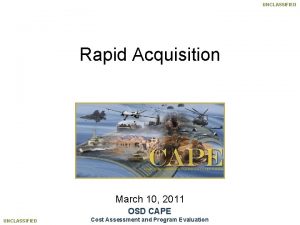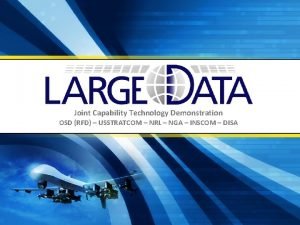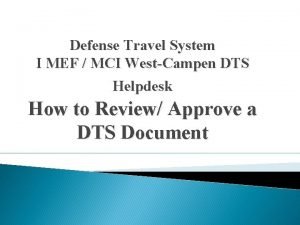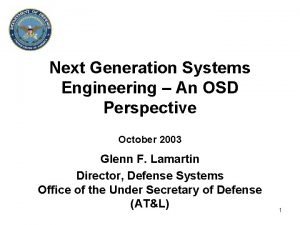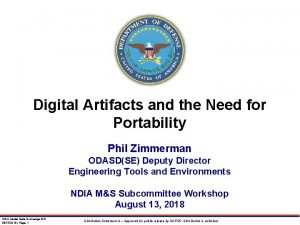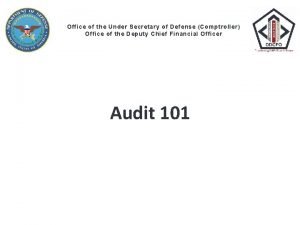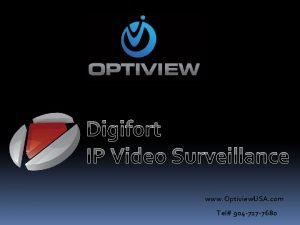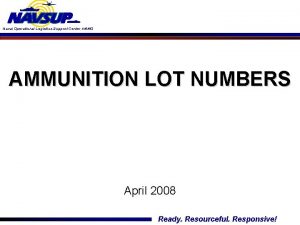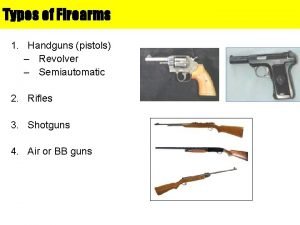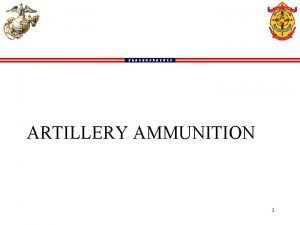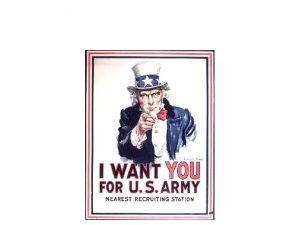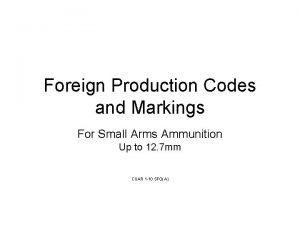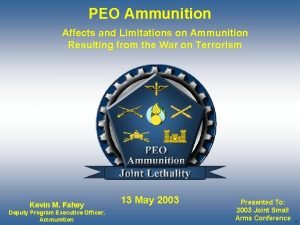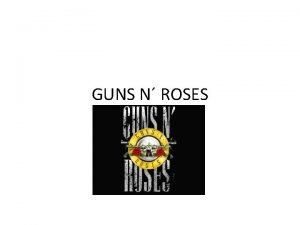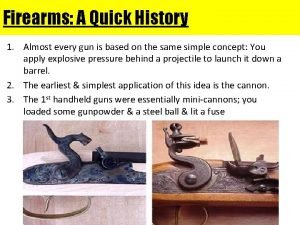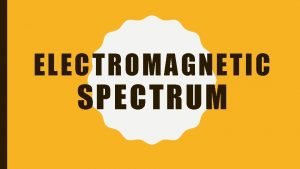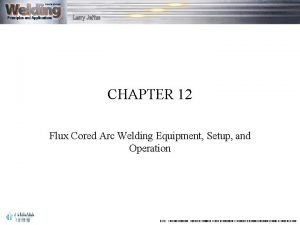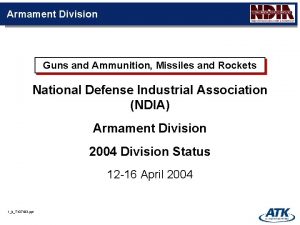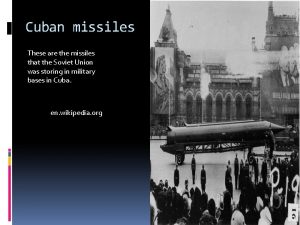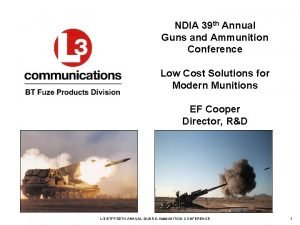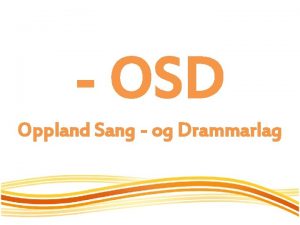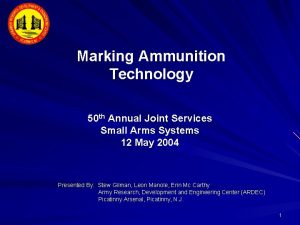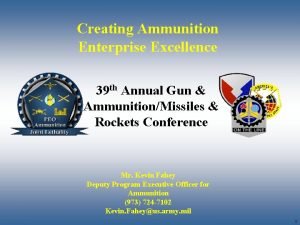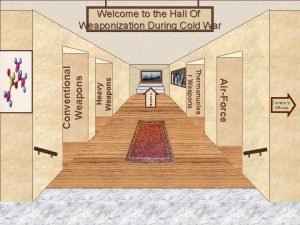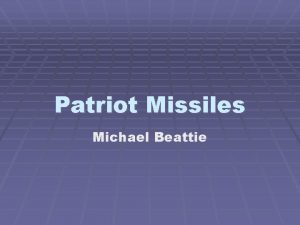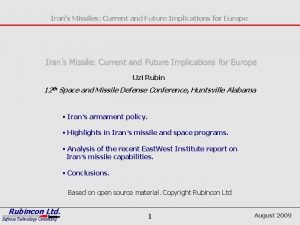OSD Perspectives 39 th Annual Guns Ammunition Missiles



























- Slides: 27

OSD Perspectives 39 th Annual Guns & Ammunition / Missiles & Rockets Conference & Exhibition April 13, 2004 Anthony J. Melita OUSD (Acquisition, Technology & Logistics) Deputy Director, Defense Systems, Land Warfare and Munitions

ü OSD Organization ü Do. D Transformation ü Requirements and Acquisition Process Changes 2/27

3/27

UNDER SECRETARY OF DEFENSE (ACQUISITION, TECHNOLOGY AND LOGISTICS) (Acting) Honorable Michael W. Wynne 695 -2381 3 E 933 __________________________ PRINCIPAL DEPUTY Honorable Michael W. Wynne 697 -7021 3 E 1006 DUSD, INSTALLATIONS & ENVIRONMENT Mr. Ray Du. Bois 3 E 792 695 -2880 DEPUTY UNDER SECRETARY OF DEFENSE (ACQUISITION & TECHNOLOGY) Honorable Michael W. Wynne 3 E 1006 697 -7021 DUSD, INDUSTRIAL POLICY Miss Suzanne Patrick 3 E 1060 697 -0051 DUSD, INTERNATIONAL TECHNOLOGY SECURITY Dr. John A. Shaw 3 E 1034 693 -0011 DIR, SMALL & DISADVANTAGED BUSINESS UTILIZATION Mr. Frank Ramos RPN Suite 9100 588 -8620 DIR, DEFENSE SYSTEMS Dr. Glenn F. Lamartin 3 E 130 697 -9386 DIR, DEFENSE PROCUREMENT & ACQUISITION POLICY Ms. Deidre A. Lee 3 E 1044 695 -7145 DIR, DEFENSE CONTRACT MANAGEMENT AGENCY BG Ed Harrington, USA 6350 Walker LA 428 -1703 DIR, ACQUISITION RESOURCES & ANALYSIS Dr. Nancy L. Spruill 3 E 1025 614 -5737 DIR, INTERNATIONAL COOPERATION Mr. Alfred G. Volkman 3 A 280 697 -4172 DIR, SPECIAL PROGRAMS RADM(L) Richard P. Terpstra, USN 3 D 1064 697 -1282 ATSD NUCLEAR & CHEMICAL & BIOLOGICAL DEFENSE PROGRAMS DIRECTOR DEFENSE RESEARCH & ENGINEERING Honorable Dale E. Klein 3 E 1074 697 -1771 Honorable Ronald Sega 3 E 1014 697 -5776 DATSD, NUCLEAR MATTERS Mr. Frederick S. Celec 3 C 125 697 -3060 DUSD, SCIENCE & TECHNOLOGY Dr. Charles Holland 3 E 114 695 -0598 DATSD, CHEM/BIOLOGICAL DEFENSE Dr. Anna Johnson-Winegar 3 C 257 693 -9410 DUSD, ADVANCED SYSTEMS & CONCEPTS Ms. Sue C. Payton 3 E 144 697 -6446 DATSD, NUCLEAR TREATY PROGRAMS (Vacant) Wilson Blvd 588 -1983 DUSD, LABORATORIES & BASIC SCIENCES Dr. John Hopps, Jr. 3 E 114 692 -4592 DIR, DEFENSE THREAT REDUCTION AGENCY Dr. Stephen Younger (IPA) FT BEL 767 -4883 DIR, DEFENSE ADVANCED RESEARCH PROJECTS AGENCY Dr. Anthony Tether VSB 983 696 -2400 DIR, ADMINISTRATION Ms. Julie K. Bigler 3 D 1020 697 -2525 EXEC DIR, DEFENSE SCIENCE BOARD Mr. Brian Hughes 3 D 865 695 -4157 DEPUTY UNDER SECRETARY OF DEFENSE (LOGISTICS & MATERIEL READINESS) Honorable Diane Morales 3 E 808 697 -5531 ADUSD, TRANSPORTATION POLICY Mr. Earl B. Boyanton, Jr. CGN 210 A 601 -4461 DIRECTOR MISSILE DEFENSE AGENCY Lt Gen Ronald T. Kadish, USAF NAVY ANNEX 695 -6344 ADUSD, SUPPLY CHAIN INTEGRATION Mr. Alan Estevez CGN 210 B 604 -0098 ADUSD, MAINTENANCE POLICY, ADUSD, LOGISTICS PLANS PROGRAM & RESOURCES & PROGRAMS MATERIEL READINESS Mr. Louis A. Kratz Mr. Robert T. Mason 2 C 263 614 -6327 3 B 915 697 -7980 ADUSD, LOGISTICS SYSTEMS MANAGEMENT Ms. Laura A. Faught CGN 406 604 -0157 DIR, DEFENSE LOGISTICS AGENCY VADM Keith W. Lippert, USN FT BEL 767 -5200 4/27

DEFENSE SYSTEMS ORGANIZATION DS Asst for DS Planning Defense Systems Director Principal Deputy SE SA Systems Engineering Enterprise Development Test & Evaluation Air Warfare SMI Systems Acquisition Director: Mr. Schaeffer Systems and Mission Integration Director: Dr. Lamartin Assessments & Support Land Warfare & Munitions Asst for DS Projects Dr. Glenn Lamartin Mr. Mark Schaeffer Director: Joint Force Integration Naval Warfare Missile Warfare Dr. Garber Joint Force Application Joint Force Operations Treaty Compliance 5/27

Transformation /27

Transformation “…a future force that is defined less by size and more by mobility and swiftness, one that is easier to deploy and sustain, one that relies more heavily on stealth, precision weaponry and information technologies. ” George W. Bush 7/27

The Emerging American Military*: • More expeditionary (lighter, more lethal) • More networked (more interoperability at the JTF level) • Designed to leverage the exterior positions (precision from distance as sensors move in) • Leverages increasingly persistent ISR • Tighter sensor-shooter timelines (sensing, C 2, fly-out) • Values Information Superiority (information operations) • Focused on unmanned capabilities (UAV, UCAV, UUV, robotics) * Transforming Defense…. General Observations, Office of Force Transformation 8/27

Strategy for Transforming • Transformed culture through innovative leadership – Strong commitment from senior leaders • Transformed processes – Reformed capabilities-identification process (joint operating concepts) – Strategic analysis that can identify and assess risks for strategic planning • Transformed capabilities through force transformation Source: Do. D Transformation Planning Guidance, April 2003 9/27

Scope of Transformation • Transforming how we fight – Joint warfighting concepts – Doctrine, organization, training, materiel, leadership and education, personnel and facilities. • Transforming how we do business – Legislative reforms – Requirements generation and acquisition processes – Adaptive war planning • Transforming how we work with others – Coordination among agencies (federal, state, local) – Allied and coalition partners Source: Do. D Transformation Planning Guidance, April 2003 10/27

Requirements and Acquisition Process Changes /27

Acquisition Decision Support Systems In Transformation Joint Capabilities Integration & Development System (JCIDS) CJCS 3170. 01 C 24 June 03 Revolutionary VCJCS/Service Chief Oversight MID 913 PPBS to PPBE 22 May 03 Evolutionary Defense Acquisition System Milestone Decision Authority (MDA) Oversight Do. D 5000 Series 12 May 03 Revision Planning, Programming, Budgeting & Execution Process (PPBE) DEPSECDEF Oversight Emerging 12/27

Joint Capabilities Integration and Development System Summary of Changes • Enhance methodology to identify and to describe capabilities gaps • Engage the acquisition community earlier • Better define non-material aspects of material solutions • Prioritize capability gaps and proposals • Improved coordination with other departments and agencies • Mandate broader review of capability proposals 13/27

Functional Capabilities Boards • • • Responsibilities Ensure new capabilities are conceived and developed in joint warfighting context Ensure JCIDS proposals are consistent with integrated joint force Validate Joint Impact proposals Organize, analyze & prioritize capabilities proposals Oversee development and update of Functional Concept(s) Ensure integrated architectures (as available) reflect functional area • 7 Chartered by JROC: – – – – Command & Control (JFCOM); Battlespace Awareness (J 2); Force Application (J 8); Focused Logistics (J 4) Protection (J 8) Network Centric (J 6) Force Management (J 8) More Efficient Use of Scarce Department Resources 14/27

Functional Capability Area Portfolios Battlespace Awareness Command & Control Net Centric Force Application Force Protection Focused Logistics JS J-8 JS J-4 Portfolio JS J-6 JS J-2 JFCOM J-8 Portfolio – All source intel collection – Environmental data collection – Knowledge management – Predictive analysis – SJFHQ – DJC 2 – Collaborative Information Environment – Integrated Fires/Targeting (Combat ID & Integrated Ops Pictures – Effects-based Ops/Planning – Joint Commander Impact Issues (C 2) – IT & NSS systems and integration – Warfighting CCE systems – Cryptographic systems – National-totactical C 4 integration – Land, maritime, air & space ops – Joint targeting – Conventional and nuclear atk – Close and urban combat – Joint fires – SEAD – Special ops – Information Operations (CNA/CND/EW/ PSYOP/Military Deception/ OPSEC) – Personnel and infrastructure protection – Homeland security – Air and Missile Defense – Consequence management – Proliferation control Portfolio – Deployment/ distribution – Mobility – Sustainment – Force Health Protection – Logistics C 2 15/27

Oversight Body Comparison Joint Requirements Panel (JRP) • Services • DIA Representative (Intelligence Supportability) Functional Capabilities Board (FCB) • • • Services Combatant Commanders USD (AT&L) USD (I) USec. AF (Space) ASD NII/ DOD CIO D, PA&E DIA Representative (Intelligence Supportability) Mission requirements board Executive Secretary Advisory Membership – J-6 E/I (Interoperability Advisor) – J-8 Warfighting Concepts and Architectures Integration – DOD Laboratories & Industry Joint Requirements Board (JRB) Joint Capabilities Board (JCB) Joint Requirements Oversight Council (JROC) 16/27

The Defense Acquisition Management Framework 17/27

Revised Policy Objectives • • • Streamline Increase Flexibility Enhance Business Practice Emphasize Evolutionary Acquisition Integrate Acquisition Business Model with transformed Requirements Generation System 18/27

Evolutionary Acquisition • Two development processes to implement Evolutionary Acquisition Strategy – • • Incremental Development: End-state requirement is known, and requirement will be met over time in several increments – Spiral Development: Desired capability is identified, but endstate requirements are not known at Program Initiation. Requirements for future increments dependent upon technology maturation and user feedback from initial increments Evolutionary acquisition strategies shall be preferred approach to satisfying operational needs. Spiral development shall be the preferred process. 19/27

Planning, Programming, Budgeting and Execution • Primary Resource Management System for Do. D: – Articulates strategy – Identifies size, structure and equipment for military forces – Sets programming priorities – Allocates resources – Evaluates actual output against planned performance and adjusts resources as appropriate 20/27

4 Administration Years with 2 -year PPBE Cycle JAN FEB MAR APR MAY JUN JUL AUG SEP OCT NOV DEC FY 07 -11 Year 1 New Admin “Review and Refinement” Off-year DPG Program Budget Review Year 2 Modify Budget Submission (previous administration) * Budget Execution (previous administration) FY 08 -13 “Formalizing the Agenda” QDR to Congress On-year DPG QDR Prep PCP/BCP POM/BES Program Budget Review Budget Submission Year 1 Budget Execution Year 1 FY 09 -13 Year 3 “Execution of Guidance” Off-year DPG Program PCP/BCP Budget Review Budget Submission Year 2 Budget Execution Year 2 FY 06 -11 Year 4 “Ensuring the Legacy” On-year DPG POM/BES Electio Program n Budget Review Budget Execution Year 3 Budget Submission Year 3 We are here! 21/27

Planning Phase DEC 1 st Year President MAR 2 nd Year 1 st year of a new administration CPR JCS COCOMs SERVICES NMS Strategy also reflected in QDR MAY COCOM – Combatant Command CPR – Chairman’s Pgm Recommendation JPG – Joint Programming Guidance NSS – National Security Strategy NMS – National Military Strategy QDR – Quadrennial Defense Review SPG – Strategic Planning Guidance National Security Council CIA/DIA/JCS/OSD NSS FEB SPG DRAFT JPG JCS, OSD, COCOMs, SVC HQs, ETC. SECDEF JPG 22/27

Concurrent Program/Budget Review (“On-year”) AUG OSD/ OMB Issue Resolution SECDEF DRB POM Services PEO/PM, SVC HQs COCOMs BES Updates FYDP NOV OCT JCS OSD/ OMB CPA PDM DEC JAN/FEB BES – Budget Estimate Submission COCOM – Combatant Command CPA – Chairman’s Pgm Assessment DRB – Defense Resources Board MBI – Major Budget Issues PB – President’s Budget PBD – Program Budget Decision PDM – Program Decision Memo POM – Program Objectives Memo Adv Ques/ Hearings PBDs Services / PEO / PM Answer / Reclama MBI PB Updates FYDP 23/27

Off-Year Program/Budget Review AUG NOV OCT OSD/ OMB Accepted PCP Resolution SECDEF DRB PCPs Services PEO/PM, SVC HQs COCOMs JCS PDM CPA OSD/ OMB BCPs DEC JAN/FEB BCP – Budget Change Proposal COCOM – Combatant Command CPA – Chairman’s Pgm Assessment DRB – Defense Resources Board MBI – Major Budget Issues PB – President’s Budget PBD – Program Budget Decision PCP – Program Change Proposal PDM – Program Decision Memo Adv Ques/ Hearings PBDs MBI PB Services / PEO / PM Answer / Reclama 24/27

Program Change Proposals (PCPs) • Identify areas to take additional risk (offsets) – Offsets may be used for other initiatives • Limited to items that exceed $250 million across FYDP – Threshold at individual programmatic issue level – May address smaller issues if serious programmatic problem – If less than $250 million, may submit as BCP if budget year is affected • Must comply with PDM decisions • Combatant Commanders may submit up to six prioritized PCPs regardless of dollar value • Full budgetary data submitted for accepted PCPs 25/27

Budget Change Proposals (BCPs) • Generally limited to fact-of-life changes: – Cost increases – Schedule delays – Management reform savings – Workload changes – Budget execution experience – Congressional action • May involve FYDP years if total cost is less than $250 million and budget year is affected • Offsets required • Backed up with appropriate budget exhibits 26/27

Final Thoughts…. . Deliver Advanced Technology Faster • Improved integration of business practice • Focus on Joint Capabilities • Flexible, outcome-based, Acquisition Management Framework • PPBE Interface aligned with JCIDS and Acquisition Process Improved Business Practices meet the 21 ST Century Challenge 27/27
 Logical fallacies exercise
Logical fallacies exercise Missiles have predetermined trajectories
Missiles have predetermined trajectories Missile word scramble
Missile word scramble Osd cape
Osd cape Jctd-404
Jctd-404 Defence travel system
Defence travel system Osd systems engineering
Osd systems engineering Osd bssn
Osd bssn Osd digital engineering strategy
Osd digital engineering strategy Department of defense comptroller
Department of defense comptroller Tethered cord
Tethered cord Digifort ip surveillance
Digifort ip surveillance Osd
Osd Navy ammunition logistics code
Navy ammunition logistics code Bullet anatomy
Bullet anatomy Artillery ammunition identification
Artillery ammunition identification Wars involving us
Wars involving us 二戰英文
二戰英文 Sunflower ammunition plant
Sunflower ammunition plant Polygonal rifling
Polygonal rifling Ketf ammunition
Ketf ammunition вуфл
вуфл Peo gcs org chart
Peo gcs org chart Valvet revolver
Valvet revolver In 1816 took a little trip
In 1816 took a little trip Chamber mark
Chamber mark Raging martians invaded venus using x-ray guns
Raging martians invaded venus using x-ray guns What does the fca flux provide to the weld
What does the fca flux provide to the weld
